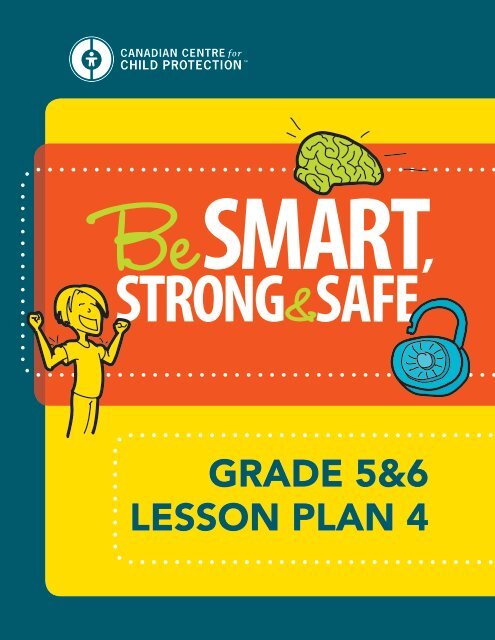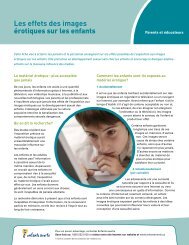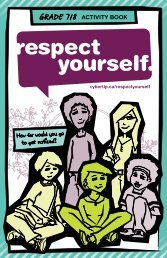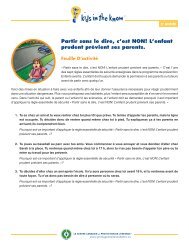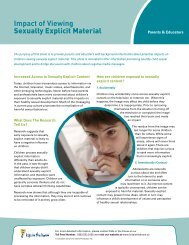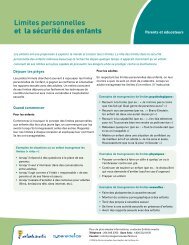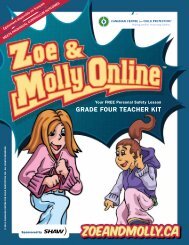GRADE 5&6 LESSON PLAN 4 - Kids in the Know
GRADE 5&6 LESSON PLAN 4 - Kids in the Know
GRADE 5&6 LESSON PLAN 4 - Kids in the Know
You also want an ePaper? Increase the reach of your titles
YUMPU automatically turns print PDFs into web optimized ePapers that Google loves.
,<br />
<strong>GRADE</strong> 5&6<br />
<strong>LESSON</strong> <strong>PLAN</strong> 4
,<br />
<strong>LESSON</strong> 4<br />
BOUNDARIES AND INSTINCTS<br />
Outcome<br />
• Students will learn how to respect boundaries.<br />
• Students will learn and understand that<br />
all people deserve dignity and respect.<br />
• Students will learn <strong>the</strong> difference<br />
between appropriate touch and<br />
touch that breaks boundaries.<br />
• Students will understand that if <strong>the</strong>y<br />
feel uncomfortable, confused, or scared<br />
<strong>the</strong>y need to talk to a trusted adult.<br />
Required Materials<br />
• Be Smart, Strong & Safe booklet<br />
• Okay Touch and Not Okay Touch Posters<br />
• Red/Green Paper*<br />
• Red/Green Card*<br />
• Sexual Abuse Senario Activity<br />
Note: materials with an (*) are not supplied.<br />
Suggested Time: 50 m<strong>in</strong>utes<br />
Presentation<br />
ACTIVATE PRIOR KNOWLEDGE<br />
The Creepy Meter (10 m<strong>in</strong>utes)<br />
Hand out Be Smart, Strong and Safe booklets<br />
to students.<br />
Expla<strong>in</strong> <strong>the</strong> follow<strong>in</strong>g to students:<br />
On pages 8 and 9 of your Be Smart, Strong and<br />
Safe booklets I want you to connect <strong>the</strong> dots to f<strong>in</strong>d<br />
out what is go<strong>in</strong>g on <strong>in</strong> <strong>the</strong> pictures. The purpose<br />
of this activity is to learn how to trust your <strong>in</strong>st<strong>in</strong>cts.<br />
After you have connected <strong>the</strong> dots fill <strong>in</strong> <strong>the</strong> creepy<br />
meter at <strong>the</strong> bottom of <strong>the</strong> page.<br />
Say:<br />
“What is happen<strong>in</strong>g <strong>in</strong> <strong>the</strong> picture on page 8”<br />
“Where on <strong>the</strong> creepy meter did your <strong>in</strong>st<strong>in</strong>cts tell<br />
you this situation should be”<br />
“How did you decide this”<br />
“What is happen<strong>in</strong>g <strong>in</strong> <strong>the</strong> picture on page 9”<br />
“Where on <strong>the</strong> creepy meter did your <strong>in</strong>st<strong>in</strong>cts tell<br />
you this situation should be”<br />
“How did you decide this”<br />
Review<strong>in</strong>g Boundaries and Putt<strong>in</strong>g Your Inst<strong>in</strong>cts<br />
(Creepy Meter) To <strong>the</strong> Test<br />
Ask:<br />
“Can anyone name ways <strong>in</strong> which you can respect<br />
someone else’s boundaries”<br />
“Can anyone name ways <strong>in</strong> which boundaries can be<br />
broken”<br />
“What should you do if someone, even someone you<br />
know, breaks a boundary”<br />
Expla<strong>in</strong> <strong>the</strong> follow<strong>in</strong>g to students:<br />
Recogniz<strong>in</strong>g when a boundary is be<strong>in</strong>g respected<br />
or broken is a key element <strong>in</strong> keep<strong>in</strong>g yourself safe.<br />
Therefore, I am go<strong>in</strong>g to read to you a scenario from<br />
<strong>the</strong> Be Smart, Strong & Safe booklet <strong>the</strong>n we are<br />
go<strong>in</strong>g to use our <strong>in</strong>st<strong>in</strong>cts to f<strong>in</strong>d out where it falls on<br />
<strong>the</strong> creepy meter. We are also go<strong>in</strong>g to look to see if<br />
<strong>the</strong>re are any boundaries be<strong>in</strong>g broken. In addition,<br />
we are go<strong>in</strong>g to give <strong>the</strong> girl <strong>in</strong> <strong>the</strong> story advice<br />
about what she should have done.<br />
Note: Emphasize for students not to focus on <strong>the</strong><br />
appearance of a person to determ<strong>in</strong>e if s/he may be<br />
dangerous, but <strong>the</strong> way s/he acts.<br />
<strong>LESSON</strong> FOUR | Boundaries As They Refer To Sexual Respect<br />
2
,<br />
SCENARIO: Lucky Break (10 m<strong>in</strong>utes)<br />
Refer to <strong>the</strong> true story Lucky Break on pages 4-5<br />
of <strong>the</strong> Be Smart, Strong & Safe booklet.<br />
Th<strong>in</strong>k-Pair-Share:<br />
• Read <strong>the</strong> true story Lucky Break to <strong>the</strong> class.<br />
Have <strong>the</strong> class follow along with you.<br />
• Note: Instruct students to cover up Dear<br />
Jealous so <strong>the</strong>y can come up with <strong>the</strong>ir<br />
own solution and compare it to Kate’s.<br />
• Allow students time to f<strong>in</strong>d at least<br />
3 th<strong>in</strong>gs that seem weird about what<br />
happened to Jealous’ friend.<br />
• Have students turn to a partner and share<br />
what <strong>the</strong>y found weird about <strong>the</strong> story.<br />
• Choose volunteers to share <strong>the</strong>ir answers.<br />
• Have students turn to page 20<br />
to compare <strong>the</strong>ir answers.<br />
• Discuss all answers and clarify<br />
or expand if needed.<br />
Guided Practice<br />
Acquir<strong>in</strong>g New Information<br />
Class Discussion (15 m<strong>in</strong>utes)<br />
Expla<strong>in</strong> <strong>the</strong> follow<strong>in</strong>g to students:<br />
Now that we have picked out <strong>the</strong> weirdness from <strong>the</strong><br />
scenario Lucky Break and have thought about good<br />
advice to give Jealous we are go<strong>in</strong>g to cont<strong>in</strong>ue our<br />
discussion about respect<strong>in</strong>g boundaries but as <strong>the</strong>y<br />
refer to sexual abuse and sexual respect.<br />
Have students read page 10 <strong>in</strong> <strong>the</strong> Smart, Strong<br />
and Safe booklet. Ask students what would be<br />
considered “weird” behaviour <strong>the</strong>y should pay<br />
attention to. Toge<strong>the</strong>r read <strong>the</strong> scenarios on page 11.<br />
Discuss with students.<br />
1. Expla<strong>in</strong> when you need to talk to a trusted adult.<br />
Have students, <strong>in</strong> pairs, complete pages 12 and 13.<br />
Go over <strong>the</strong> answers toge<strong>the</strong>r.<br />
Expla<strong>in</strong> <strong>the</strong> follow<strong>in</strong>g to students:<br />
People you don’t know, even people you do know,<br />
can break boundaries. It is essential that you tell<br />
an adult you trust when someone is break<strong>in</strong>g<br />
boundaries. If someone touches or tries to touch <strong>the</strong><br />
private area of your body, you have <strong>the</strong> right to say<br />
“No!”. Even if <strong>the</strong> person tells you to keep it a secret,<br />
you need to tell a trusted adult. Secrets shouldn’t<br />
make anyone uncomfortable, hurt, or scared. These<br />
k<strong>in</strong>ds of secrets are <strong>the</strong> ones we need to speak out<br />
about to an adult we can trust. It is very important<br />
to always trust your <strong>in</strong>st<strong>in</strong>cts and tell a trusted adult<br />
if you are uncomfortable, confused, and or scared.<br />
If one adult doesn’t listen to you, tell ano<strong>the</strong>r one.<br />
Keep tell<strong>in</strong>g until someone listens.<br />
2. If someone has ever done someth<strong>in</strong>g to you that<br />
made you feel uncomfortable but you did not say<br />
“No” it’s still not your fault. You can still, and should,<br />
tell a trusted adult. This can be a very hard th<strong>in</strong>g to<br />
do. Why do you th<strong>in</strong>k this can be difficult to do<br />
Expla<strong>in</strong> <strong>the</strong> follow<strong>in</strong>g to students:<br />
If someone makes you feel uncomfortable or you<br />
know someth<strong>in</strong>g has happened that is wrong, you<br />
need to tell an adult about it – even if, for any reason,<br />
you didn’t tell <strong>the</strong> person to stop. It’s never a child’s<br />
fault when an adult touches <strong>the</strong>m <strong>in</strong>appropriately or<br />
asks <strong>the</strong>m to do <strong>in</strong>appropriate th<strong>in</strong>gs. You need to<br />
tell a trusted adult about someth<strong>in</strong>g an adult does<br />
that makes you feel uncomfortable or awkward even<br />
if that person seems like a very important person and<br />
is really liked by your family.<br />
<strong>LESSON</strong> FOUR | Boundaries As They Refer To Sexual Respect<br />
3
,<br />
3. Expla<strong>in</strong> that it is an adult’s job to protect children.<br />
Expla<strong>in</strong> that even if you know <strong>the</strong> person and/or your<br />
parents know <strong>the</strong> person <strong>the</strong>y do not have <strong>the</strong> right<br />
to break boundaries – everyone deserves dignity and<br />
respect. You have to pay attention to your <strong>in</strong>st<strong>in</strong>cts.<br />
If your <strong>in</strong>st<strong>in</strong>cts tell you that someth<strong>in</strong>g is weird/<br />
uncomfortable/strange or if your creepy meter goes<br />
off you need to tell a trusted adult.<br />
Expla<strong>in</strong> <strong>the</strong> follow<strong>in</strong>g to students:<br />
It can be really confus<strong>in</strong>g when an adult you really<br />
like does someth<strong>in</strong>g that you feel bad about. This<br />
could be touch<strong>in</strong>g your private areas, show<strong>in</strong>g you<br />
his/her private areas or say<strong>in</strong>g someth<strong>in</strong>g sexual that<br />
makes you feel strange. It’s an adult’s job to help<br />
protect children.<br />
4. Expla<strong>in</strong> that some adults need help to stop hurt<strong>in</strong>g<br />
children and by tell<strong>in</strong>g your trusted adult, <strong>the</strong>se<br />
adults will get <strong>the</strong> help <strong>the</strong>y need and not hurt o<strong>the</strong>r<br />
children.<br />
Expla<strong>in</strong> <strong>the</strong> follow<strong>in</strong>g to students:<br />
Some adults need help so that <strong>the</strong>y stop treat<strong>in</strong>g kids<br />
<strong>in</strong>appropriately. It’s okay for you to tell an adult that<br />
you trust about anyth<strong>in</strong>g you are unsure about. It’s<br />
always best to check th<strong>in</strong>gs out with someone else<br />
you trust to see what he or she th<strong>in</strong>ks.<br />
Ask:<br />
“What does sexual abuse mean”<br />
• Have students turn to page 21 of <strong>the</strong><br />
Be Smart, Strong & Safe booklet and read<br />
<strong>the</strong> def<strong>in</strong>ition of sexual abuse as a class.<br />
• Answer any questions at this time.<br />
Expla<strong>in</strong> <strong>the</strong> follow<strong>in</strong>g to students:<br />
“A car<strong>in</strong>g touch like a hug from a trusted adult that<br />
doesn’t make you feel uncomfortable is healthy and<br />
really important. You can listen to your <strong>in</strong>st<strong>in</strong>cts. If an<br />
adult touches you <strong>in</strong> a way that makes your “creepy<br />
meter” go off <strong>the</strong>n listen to yourself. That’s when it’s<br />
time to tell a trusted adult that someth<strong>in</strong>g is wrong.”<br />
Read page 15 of <strong>the</strong> Be Smart, Strong & Safe<br />
booklet aloud to <strong>the</strong> class.<br />
Closure<br />
APPLYING NEW INFORMATION<br />
Create Examples (15 m<strong>in</strong>utes)<br />
Ask pairs of students to write an example of<br />
someone break<strong>in</strong>g boundaries and an example of<br />
someone respect<strong>in</strong>g boundaries.<br />
5. Expla<strong>in</strong> to students that everyth<strong>in</strong>g discussed<br />
above refers to sexual respect. Reiterate that<br />
everyone deserves dignity and respect.<br />
Expla<strong>in</strong> <strong>the</strong> follow<strong>in</strong>g to students:<br />
Sexual respect means that you respect yours’<br />
and o<strong>the</strong>rs’ right to say ‘no’ when it comes to<br />
attention and behaviour that feels <strong>in</strong>appropriate and<br />
uncomfortable.<br />
Follow-Up<br />
Re<strong>in</strong>force respectful behaviours demonstrated by<br />
students throughout <strong>the</strong> year.<br />
Additional Resources<br />
• Visit www.kids<strong>in</strong><strong>the</strong>know.ca for additional<br />
resources and <strong>in</strong>formation about child safety.<br />
• We welcome your feedback at<br />
feedback@kids<strong>in</strong><strong>the</strong>know.ca.<br />
<strong>LESSON</strong> FOUR | Boundaries As They Refer To Sexual Respect<br />
4


